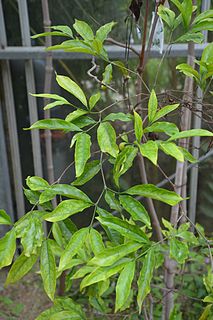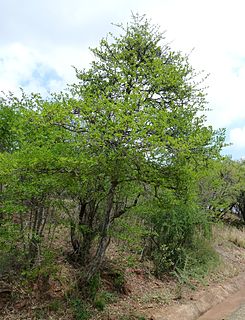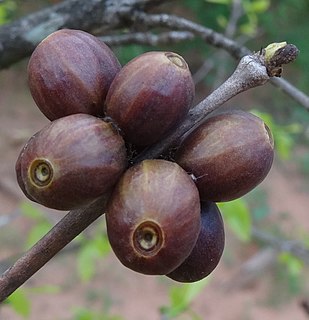
Alberta is a monotypic genus of flowering plants in the family Rubiaceae. Most species have been transferred to the genus Razafimandimbisonia, except for the type species Alberta magna. It is native to KwaZulu-Natal, South Africa and is commonly known as Natal flame bush.
Bertiera pauloi is a species of flowering plant in the family Rubiaceae. It is endemic to Tanzania.
Afrocanthium keniense is a species of flowering plant in the family Rubiaceae. It is endemic to Kenya. It is threatened by habitat loss.
Afrocanthium kilifiense is a species of flowering plant in the family Rubiaceae. It is endemic to Kenya.
Afrocanthium shabanii is a species of flowering plant in the family Rubiaceae. It is endemic to Tanzania.
Afrocanthium siebenlistii is a species of flowering plant in the family Rubiaceae. It is endemic to Tanzania, found only in the Usambara and Uzungwa Mountains.
Afrocanthium vollesenii is a species of flowering plant in the family Rubiaceae. It is endemic to Tanzania.
Gaertnera longifolia is a species of plant in the family Rubiaceae. It is endemic to Mauritius. Its natural habitat is subtropical or tropical dry forests. It is threatened by habitat loss.

Guettarda is a plant genus in the family Rubiaceae. Most of these plants are known by the common name Velvetseed. Estimates of the number of species range from about 50 to 162. Most of the species are neotropical. Twenty are found in New Caledonia and one reaches Australia. A few others are found on islands and in coastal areas of the Indian and Pacific Oceans.
Pavetta tarennoides is a species of plant in the family Rubiaceae. It is endemic to Kenya.
Psychotria taitensis is a species of plant in the family Rubiaceae. It is endemic to Kenya.

Rothmannia annae is a species of plant in the family Rubiaceae. It is endemic to the Seychelles. It is found in its natural state only on Aride Island, where its habitat is protected by Island Conservation Society.
Empogona acidophylla is a species of plant in the family Rubiaceae. It is endemic to Tanzania.

Rondeletia is a genus of flowering plants in the family Rubiaceae. It is endemic to the Neotropics. There are around 160 species.

Afrocanthium is a genus of flowering plants in the family Rubiaceae. It consists of deciduous, unarmed trees, and shrubs. They are native to East Africa, from Sudan and Ethiopia to South Africa.

The World's 25 Most Endangered Primates is a list of highly endangered primate species selected and published by the International Union for Conservation of Nature (IUCN) Species Survival Commission (SSC) Primate Specialist Group (PSG), the International Primatological Society (IPS), Global Wildlife Conservation (GWC), and Bristol Zoological Society (BZS). The IUCN/SSC PSG worked with Conservation International (CI) to start the list in 2000, but in 2002, during the 19th Congress of the International Primatological Society, primatologists reviewed and debated the list, resulting in the 2002–2004 revision and the endorsement of the IPS. The publication was a joint project between the three conservation organizations until the 2012–2014 list when BZS was added as a publisher. The 2018–2020 list was the first time Conservation International was not among the publishers, replaced instead by GWC. The list has been revised every two years following the biannual Congress of the IPS. Starting with the 2004–2006 report, the title changed to "Primates in Peril: The World's 25 Most Endangered Primates". That same year, the list began to provide information about each species, including their conservation status and the threats they face in the wild. The species text is written in collaboration with experts from the field, with 60 people contributing to the 2006–2008 report and 85 people contributing to the 2008–2010 report. The 2004–2006 and 2006–2008 reports were published in the IUCN/SSC PSG journal Primate Conservation,, since then they have been published as independent publications.
Plocama tinctoria is a species of flowering plant in the family Rubiaceae. It is endemic to northern Somalia and the Socotra archipelago of Yemen. Its natural habitat is subtropical or tropical dry forests. It is listed by the IUCN as a threatened species under the basionym Gaillonia tinctoria.

Coffea racemosa, also known as racemosa coffee and Inhambane coffee, is a species of flowering plant in the family Rubiaceae. It has naturally low levels of caffeine, less than half of that found in Coffea arabica, and a quarter of that in Robusta coffee. It is endemic to the coastal forest belt between northern KwaZulu-Natal in South Africa and Zimbabwe, found in an area less than 150 km2 (58 sq mi) in size. It was widely cultivated by the Portuguese during the 1960-1970s in Mozambique, currently there are only two plantations at Ibo Island and in Hluhluwe, which remain.







